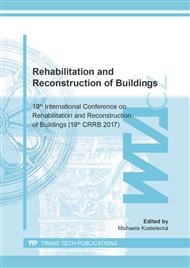p.37
p.41
p.46
p.51
p.55
p.59
p.66
p.70
p.76
Non-Destructive Schmidt Rebound Hammer Evaluation of the Degradation of Concrete Exposed to Elevated Temperatures
Abstract:
Concrete suffers significant changes in its internal structure due to fire exposition. Chemical and physical transformations cause further changes in its properties [1]. The research focuses on non-destructive Schmidt rebound hammer testing of experimental concrete panels exposed to high temperature. Five concrete panels with the dimensions of 2300 × 1300 × 150 mm were made from concrete of ordinary fire-resistance. According to the standard temperature curve in EN 1991-1-2 [2], the specimens were heated up to the target temperature (550, 600, 800 and 1000 °C) and afterwards, the given thermal load was maintained for 60 more minutes. The equation of the standard temperature curve represents a common fire by which a building structure may be affected in rare cases. The rebound hammer SilverSchmidt L and Original Schmidt N was used for determining the rebound number. Rebound number area charts of all experimental panels were created in order to identify most damaged areas of the concrete due to the effects of high temperatures. Differences between values of destructive and non-destructive compressive strength were determined.
Info:
Periodical:
Pages:
55-58
Citation:
Online since:
August 2018
Authors:
Price:
Сopyright:
© 2018 Trans Tech Publications Ltd. All Rights Reserved
Share:
Citation:


